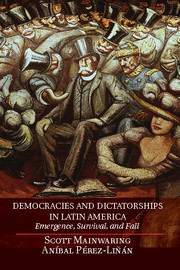Book contents
- Frontmatter
- Dedication
- Contents
- List of Tables
- List of Figures
- Acknowledgments
- 1 Introduction
- 2 A Theory of Regime Survival and Fall
- 3 Competitive Regimes and Authoritarianism in Latin America
- 4 Regime Survival and Fall
- 5 From Multiple Breakdowns to Stabilization of Democracy: Argentina
- 6 From Persistent Authoritarianism to a Durable Democracy: El Salvador
- 7 International Actors, International Influences, and Regime Outcomes
- 8 Political Regimes after the Third Wave
- 9 Rethinking Theories of Democratization in Latin America and Beyond
- Appendix 3.1 Coding Rules for Political Regimes
- Appendix 3.2 Coding U.S. Foreign Policy toward Democracy in Latin America
- Appendix 4.1 Long-Run Equilibrium for the Proportion of Competitive Regimes
- Appendix 5.1 Qualitative Comparative Analysis
- Appendix 6.1 Coding of Salvadoran Actors, 1979–2010
- Bibliography
- Index
4 - Regime Survival and Fall
A Quantitative Test
Published online by Cambridge University Press: 05 June 2014
- Frontmatter
- Dedication
- Contents
- List of Tables
- List of Figures
- Acknowledgments
- 1 Introduction
- 2 A Theory of Regime Survival and Fall
- 3 Competitive Regimes and Authoritarianism in Latin America
- 4 Regime Survival and Fall
- 5 From Multiple Breakdowns to Stabilization of Democracy: Argentina
- 6 From Persistent Authoritarianism to a Durable Democracy: El Salvador
- 7 International Actors, International Influences, and Regime Outcomes
- 8 Political Regimes after the Third Wave
- 9 Rethinking Theories of Democratization in Latin America and Beyond
- Appendix 3.1 Coding Rules for Political Regimes
- Appendix 3.2 Coding U.S. Foreign Policy toward Democracy in Latin America
- Appendix 4.1 Long-Run Equilibrium for the Proportion of Competitive Regimes
- Appendix 5.1 Qualitative Comparative Analysis
- Appendix 6.1 Coding of Salvadoran Actors, 1979–2010
- Bibliography
- Index
Summary
This chapter presents most of the quantitative evidence related to three primary research questions in this book. First, what factors help explain democratic transitions in Latin America? Second, what factors explain the breakdown of competitive regimes once established? And third, to what extent do those explanations account for the dramatic wave of democratization that began in 1978?
The chapter is structured in five sections. The first provides an operational definition of our two dependent variables (transitions and breakdowns), summarizes the strategy for statistical analysis, and uses our classification of political regimes in Latin America to document the decline in the risk of democratic breakdowns and the surprising expansion of democratic transitions that took place after 1977. The second part of the chapter introduces our control variables, which reflect alternative explanations dealing with structural preconditions, regime economic performance, and institutional factors. We discussed the operationalization of the indicators of regional diffusion effects, U.S. support for democracy, and actors’ normative regime preferences and radicalization in the previous chapter.
Section three presents the results of the statistical analysis for democratic transitions and breakdowns. Transitions are more likely to occur after other transitions have taken place in neighboring countries and when domestic political actors have a normative preference for competitive politics. We document possible indirect effects of radicalism in preventing democratic transitions. Radical opposition actors undermine dictatorships, facilitating the establishment of competitive regimes. Competitive regimes are less likely to break down when more countries in the region are democratic and when elites are committed to democratic ideals. Radicalism undermines competitive regimes indirectly through the erosion of normative preferences for democracy.
- Type
- Chapter
- Information
- Democracies and Dictatorships in Latin AmericaEmergence, Survival, and Fall, pp. 93 - 123Publisher: Cambridge University PressPrint publication year: 2014



